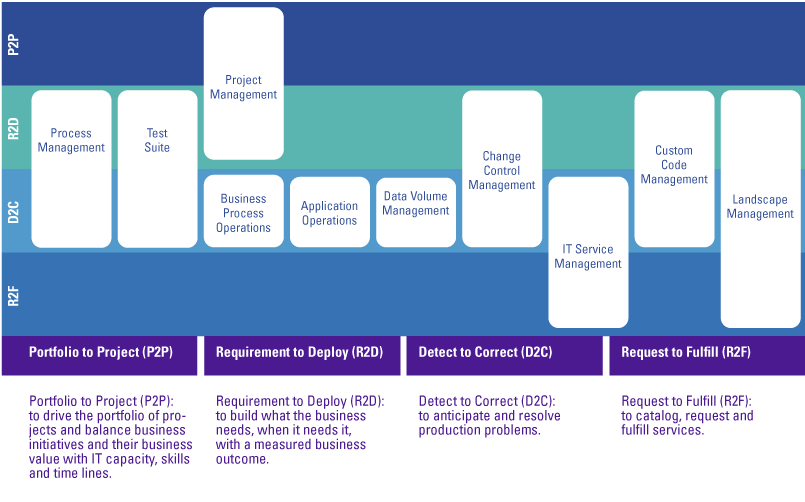When implementing and rolling out major ERP solutions, such as SAP, the risk of vendor lock-in occurs. This is especially true when doing this for multiple countries and linking the solution with every other system in the business. How can an organization retain its flexibility, but still make the best use of their powerful and complex SAP system? How can SAP implementations be improved, and how can an organization be steered towards making the existing solution run efficiently?
Introduction
The SAP system landscape has been around for about thirty years. As is typical for large ERP implementation projects, also SAP implementation projects are known for their complex and expensive set-up and most often have a delay in their delivery. Once a company starts using SAP and expands its system landscape with new functionalities and additional applications, it can become more and more dependent on this single vendor. Especially when implementing and rolling out to multiple countries or trying to integrate SAP in every business process and with every other system within the business, the risk of “vendor lock-in” occurs. How can an organization retain its flexibility, but still make the best use of their powerful and complex SAP system? Today’s leading organizations know that transforming the efficiency of back-office functions, such as finance and HR, can lead to a competitive advantage. However, this is not directly achieved by simply implementing a new ERP system. ERP systems can only create value if they achieve forecasted goals that are aligned specifically to the needs of your organization. This means for example refining a business process, automating a manual process, implementing an additional module or solution or migrating to the new generation of the ERP solution, in this case SAP S/4HANA migration. The essence of success in having the most effective SAP landscape is to keep setting new goals for optimization and continuously improving your system landscape and its governance.
In this article we will unfold the possibilities of improving SAP implementations by focusing on the full SAP-defined Solution Manager value chain and other solutions that can help reduce both business and SAP complexity. The goal of this article is to underline the importance of standardization and to indicate how standardization can be best achieved and supported by standard processes and tools to enable the organization to be flexible and ensure a smooth migration to SAP S/4HANA.
Common challenges
The first chapter focuses on complex challenges that organizations often face within their (SAP) ERP landscape, and the risk of vendor lock-in which occurs when they become too dependent on one vendor. Both issues constitute serious obstacles to an optimal maintenance of the landscape.
Origins of Complexity
According to [Dijke13], common origins of complexity include:
- Multiple (technical) solutions to meet the same business requirements across the organization (“not invented here syndrome”), e.g. the usage of distinct customizing elements to support the same process and product variants across business units. These types of complexity are commonly caused by suboptimal IT governance and lack of central oversight across custom developments and the portfolio of IT projects and applications.
- Custom developments instead of using standard (SAP) solutions (“reinventing the wheel”). This type of complexity originates from not using standard SAP solutions to solve a problem, commonly caused by limited understanding of available solutions, an outdated SAP environment and a technically oriented approach to SAP deployments.
- Technical solutions that are not used (“dead wood”), such as high amounts of unused custom developments. This type of complexity can be caused by changing business requirements and heritage from adopted SAP systems (as a result of mergers and acquisitions, for example). While these technical solutions do not add any business value, they need to be technically maintained.
Prevent vendor lock-in
Organizations may face certain issues while maintaining complex SAP landscapes: the SAP environment becomes more and more integrated with their other systems, resulting in an even higher dependency on this existing landscape. It also becomes very difficult to remain independent of an ERP vendor, which is often called vendor lock-in. Recently an increasing number of organizations have shown interest in ERP cloud solutions. Vendor lock-in, however, is recognized as being a major barrier to the adoption of cloud computing, due to lack of standardization ([Opar17]). Vendor lock-in often occurs when for example a cloud application has no standardized connectors to other systems, making it very difficult to replace a deployed solution to one from an alternative supplier. Also, due to the amount of training and knowledge building spent on a solution, switching to a different provider becomes relatively expensive ([Krem00]). In conclusion, the more organizations integrate their ERP system with the rest of their system landscape, the more difficult it becomes to steer and quickly respond to urgent requirements. Ultimately, continuous improvement and optimization should be integrated in all business processes, in order to capture the highest value from an ERP implementation.
Run better through technology
The challenges that organizations face can be addressed by taking steps and initiating improvements, supported by the proper use of technology. Some typical initiatives are reducing SAP costs, improving the system landscape, reducing the number of custom developments, and overall complexity. This chapter provides examples on how this can be achieved, and highlights some areas where issues typically arise.
Reduce SAP costs
In the last decade a lot of organizations that run SAP have taken initiatives to reduce the total cost ownership, such as system consolidation (“one SAP”), SAP in the cloud and outsourcing of functional and technical support. However, these initiatives have not always led to sustainable and significant cost savings. The main cause for this is complexity, which we will substantiate in this article. [Dijke13] point out that complexity in SAP environments may be damaging. Changes in the process from initiation to implementation take time. A lot of custom ABAP code must be maintained, as well as many (country-specific) configuration changes and a relatively high number of manual postings, corrections and rework by business users. A high amount of manual work involved in an SAP environment should therefore often be considered as a point of attention. [Krem00] stated that the value of an ERP system does not so much lie in the product itself, but in its effective and efficient usage. In order to be able to work effectively with an ERP package, the users have to be trained, and they must gain experience. This is an on-going and time-consuming process, in which the costs of changing to another system are constantly rising. In general, the older the installed system the higher the costs of a migration ([Krem00]).
Improve current landscape
To improve a current ERP implementation and to make the existing solution run efficiently, it is important to monitor a pre-defined set of factors which can impact the ability and power to improve back-office performance and efficiency. According to [Dijke13], the main goals for starting an improvement or complexity reduction project are:
- Improve organizational agility by making sure your ERP landscape and governance structure is ready for the future and flexible for possible changes.
- Simplify and standardize processes in a global SAP landscape by determining how to reduce local (non-harmonized) configuration, interfaces and custom ABAP coding.
- Reduce operating cost (realize savings) by outsourcing standardized work without losing essential knowledge about the ERP landscape and complexity.
- Improve Quality of service / service reliability, considering the increasing number of separate SAP ECC application servers (e.g. for the modules CRM, SRM, BW, APO, GRC) as well as the interfacing between them.
- Accommodate (potential) future business models (e.g. service orientation), considering the increasing use of additional (cloud-based) applications (e.g. Ariba, Hybris) on top of ECC or S/4HANA and the need for integration.
- To be able to support the use of additional SAP modules and the need for integration (e.g. Financial Supply Chain Management (FSCM), Environment Health & Safety, Foreign Trade), new business needs a certain pace to adapt to these changes.
- Adoption of new / latest technology such as (S/4)HANA to be able to respond to real-time information and realize the integration between all important business processes.
- Simplify by having a single view on data (and data quality) by decreasing the number of legacy interfaces and by decreasing ERP servers resulting from mergers and acquisitions.
Custom development reduction
While the need for a reduction of custom code is one of the points on which almost anyone working with SAP products will agree, it is not as easy to enforce in practice. Examples of possible SAP improvement opportunities can be found in various areas. The results of our SAP diagnostics phase show opportunities for simplification:
- 80% of master data maintenance is related to 20% of the master data;
- 20% of automatically determined sales order prices are manually changed;
- 20% of custom transactions are used 80% of the times;
- most SAP document types are used locally – few of them are used across company codes;
- 15% of sales order items are rejected after entry;
- more than 30% of sales orders need to be released due to delivery / credit blocks;
- 10% of the FI postings is performed manually;
- most of the VAT setup is hardly used.
1. From start implementation
The expression ‘prevention is better than cure’, is appropriate here. Carefully capturing and analyzing requirements in the preparation phase, can lead to considerable benefits later in the project. A strict change governance board which does not fall into the pressure to deliver a “quick and dirty” solution, will show its benefits not so much during the project, but throughout the entire use of the system. This results in an organization which is in control of the custom code, that has a well-thought out design, is readable and maintainable. A strict change governance structure should also promote the use of built-in functionality more instead of turning directly to the use of custom code.
2. Reduction after implementation
While this is not the preferred approach, it is still possible to improve and optimize the SAP solution after the completion of the implementation. One of the reasons this is sometimes needed is that it is not possible to foresee all possible implications of the implementation on the business processes. Additionally, incremental improvements result from a continuous monitoring of the performance of the system, not simply in technical terms, but in terms of business process performance.
Complexity reduction
KPMG makes a distinction between SAP complexity and business complexity. The latter consists of complexity in product, process and organization and is typically reflected in the SAP complexity.
An example of business complexity is the performance of business and data processes. Examples of SAP complexity are the setup of the SAP landscape and interfaces, the level of custom developments as well as complexity related to SAP operations and application management. The part of your organization responsible for operating the SAP environment, typically known as the ‘SAP competence center’, is key when defining an SAP Run Better initiative that has the objective to countermeasure unnecessary complexity.
In this article we focus on controlling SAP complexity. KPMG has defined a structured approach to identify improvements that will help the SAP Competence Centre with preventing and removing complexity by helping define organizational, process and landscape changes. Our approach to SAP complexity reduction consists of two main phases:
- assessing SAP complexity (define initial business case, orientation and complexity analysis);
- reducing SAP complexity (design the complexity reduction program and implement the program).
The objective of the assessment phase is to determine main complexity drivers, i.e. the factors that contribute significantly to the complexity of the SAP environment and the business it supports. The assessment typically focuses on all key areas of SAP complexity and is largely supported by our advanced tooling. This tool consists of a set of predefined queries to measure the level of complexity using extracts of your SAP configuration and customization settings as well as your transactional data and master data. Reducing SAP complexity consists of the design and the execution of a complexity reduction program. The design starts with determining the scope of the SAP complexity reduction program. After the scope has been defined the complexity reduction initiatives are determined for each of the identified complexity drivers. You can choose various SAP complexity reduction scenarios, varying from a pure technical SAP redesign to a full strategic business improvement scenario.
Based on our experiences, an SAP improvement initiative could involve the following projects:
- simplifying the SAP landscape by rationalizing interfaced applications;
- cleanup of “dead wood’;
- simplification of overly complex, but rewarded functional areas and IT maintenance processes;
- harmonization of processes by providing a standardized SAP solution across business units;
- making improvements / updates to programs and interfaces;
- standardization of exceptions by redesigning the processes to model frequently occurring exceptions;
- phase out of custom developments;
- implement / mandate a central process governance board.
SAP S/4HANA migration: an opportunity to run better?
One of the most current reasons for starting an improvement or complexity reduction project is the possible migration to SAP S/4HANA. This chapter focuses on the reasons to do an upgrade, the advantages of a preparation / complexity reduction project and the advantages of moving to S/4HANA.
Move to the next generation SAP
While it is not the purpose of this article to outline all the possible benefits of a move to SAP S/4HANA, it is worth mentioning that a lot of organizations consider this move as an opportunity to look into their business processes, and examine how these can be best supported by a new ERP, which has more capabilities than when they initially started with their SAP implementation, ten or more years ago. This is an opportunity to get rid of custom code, as well as simplify the SAP, and broader IT landscape.
In this process however, many of our clients face substantial issues. These challenges are due to the high number of current customizations, high number of interfaces, a build-up of landscape complexity- in part due to integration and separation of business units or other organizational entities, etc. When not carefully planned and aligned, a project that needs to be upgraded or migrated can turn into a long and painful process with a high burden on the organization, possibly resulting in a malfunctioning implemented system.
Advantages of a preparation project
Many organizations choose to start with a preparation project, as a stepping-stone towards a full-blown implementation project. With a preparation project, a careful assessment of the existing situation allows an organization to be better informed and realistically prepared for the effort and costs associated with a full project. It is at this point that the cost/benefit analysis can be made, allowing for an informed decision on whether to proceed further. The deeper the analysis is performed at this stage, and the more possible issues are discovered in this phase, the more accurate and realistic the business case will be.
Advantages of moving to S/4HANA Cloud
Moving to the cloud is not as unthinkable for most organizations, as it was just a few years ago. According to RightScale’s 2018 State of the Cloud report [RISC18], which surveyed 997 IT professionals (53% of the respondents represented enterprises with more than a thousand employees) about their current adoption and future plans involving cloud computing, 96% of survey respondents use cloud. Both public and private cloud adoption grew in 2018, with larger enterprises increasing their focus on public cloud. This is a clear indication that the cloud has quickly become an essential ingredient of modern IT.
This is due in part to the big advancements and the breadth of solutions that are now offered in the cloud. SAP has also made considerable steps in this respect, and now customers can choose between own-managed, HEC (HANA Enterprise Cloud), Private Cloud, Public Cloud.
Considerations for not moving to S/4HANA and HANA Cloud
While the arguments for moving to the cloud may fit some organizations, there are still concerns that not all the organization’s business processes and applications can be catered for by the cloud. This is an issue that needs to be managed.
Additionally, as mentioned previously, vendor lock-in is also a concern for companies willing to consider moving to the cloud. Moving to another cloud service provider in case things don’t go well with the first choice can have considerable costs and it is not straightforward. Some of the main risks include:
- data transfer risk;
- application transfer risk;
- infrastructure transfer risk;
- human resource knowledge risk.
Lastly: sometimes the answer is simply ‘not yet’. An organization might need more time to prepare for a full move to S/4HANA, be it on-premise or in the cloud.
Tools to support you
The last chapter focuses on the way SAP promotes standardization and simplification in its own product suite using for example SAP Solution Manager for on-premise SAP landscapes and SAP Cloud ALM for the SAP Cloud landscape.
Only a limited number of SAP customers use the full breadth of functionality offered in their landscape. One of the functionalities which can help implement continuous improvement, optimization and monitoring is the use of SAP Solution Manager. SAP itself describes Solution Manager as a centralized robust application management and administration solution used to implement, support, operate and monitor your SAP enterprise solutions, SAP Solution Manager is a platform providing integrated content, tools, methodologies and access to SAP systems.
According to [SAP18], there are four key value chains defined in the SAP Solution Manager Integration Model which consist of ten focus areas of SAP Solution Manager Value Report. The key value chains consist of Process Management, Test Suite, Project Management, Business Process Operations, Application Operations, Data Volume Management, Change Control Management, IT Service Management, Custom Code Management and Landscape Management. In practice these modules enable continuous monitoring and help to track developments from requirements to actual build. Solution Manager enables the user to use standardized KPIs or set up new KPIs for SAP landscape monitoring. The SAP support processes can be used to leverage the full extent of possibilities through Solution Manager.
Figure 1. SAP Solution Manager [SAP18]. [Click on the image for a larger image]
One of the main advantages of Solution Manager is, at least when mostly using SAP standard, that SAP standard analysis is available to monitor the full value chain.
With the addition of SAP Cloud ALM for SAP Cloud implementation (December 2018 release), the flexibility of cloud can now be combined with the structured approach of using Solution Manager. SAP’s roadmap is to mature SAP Cloud ALM in the next three years to support S/4HANA or C/4HANA Cloud implementations. Cloud ALM will have all/most of the functionalities of SAP Solution Manager. However, there will not be any effort required to install/configure the solution (ready to consume). The technology for the solution is completely new, taking the aspects of SAP Intelligent enterprise into account. Soon, customers will have a choice to either pick SAP Solution Manager 7.2 or SAP Cloud ALM based on their tipping point of on-premise vs cloud landscape.
Conclusion
ERP systems can only create value if they achieve forecasted goals that are aligned specifically to the needs of your organization. This means for example refining a business process, automating a manual process, implementing an additional module or solution and performing SAP S/4HANA migrations. The essence of success in having the most effective SAP landscape is to keep setting new goals for optimization and continuously improving your system landscape and the governance around it. Complexity in an SAP environment has significant consequences in terms of cost effectiveness and ability to change.
While organizations have taken various initiatives in the last decade in efforts to increase efficiency and reduce complexity, these initiatives have not all led to sustainable or significant improvements. Organizations that manage complexity in the SAP environment adequately can gain significant and sustainable cost benefits and improve their ability to change. The starting point of reducing SAP complexity is a thorough analysis of business and SAP complexity, applying a fact-based analysis of the SAP environment setup and usage. The goal is to identify unrewarded SAP complexity that does not support business requirements. Based on this analysis, a complexity reduction program can be initiated with the objective of removing the unrewarded complexity.
We see that most SAP implementations start with the goal to standardize, but usually go back to customized solutions following the implementation project due to lack of change management and change governance. It is therefore essential to recognize the importance of a strong change board that knows exactly which types of customizations are allowed and to what extent.
References
[Dijke13] Ad van Dijke & Rob Scheele, A Structured Approach to Reducing SAP Complexity, Compact 2013-3, https://www.compact.nl/articles/a-structured-approach-to-reducing-sap-complexity/, 2013.
[Krem00] M. Kremers & H. van Dissel, Enterprise resource planning: ERP system migrations, Communications of the ACM, 43(4), p. 53-56, 2000.
[Opar17] J. Opara-Martins, A decision framework to mitigate vendor lock-in risks in cloud (SaaS category) migration, doctoral dissertation, Bournemouth University, 2017.
[RISC18] RightScale, 2018 State of the Cloud Report, Rightscale.com, https://www.rightscale.com/blog/cloud-industry-insights/cloud-computing-trends-2018-state-cloud-survey, 2018.
[SAP18] SAP, Project Management in SAP Solution Manager 7.2 SP7, SAP SE, Customer Experience & Solutions, https://support.sap.com/content/dam/support/en_us/library/ssp/sap-solution-manager/container/pm/project-management-with-sap-solution-manager.pdf, 2018.






